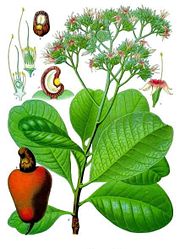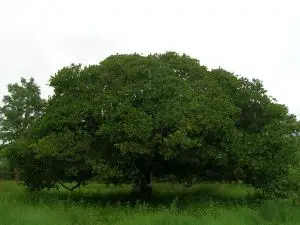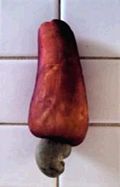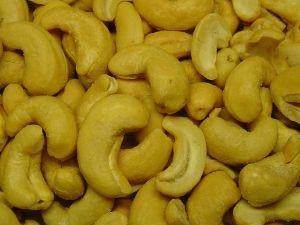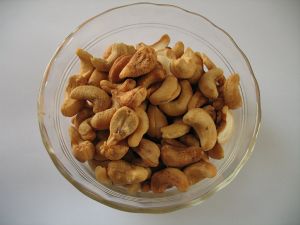Difference between revisions of "Cashew" - New World Encyclopedia
({{Contracted}}) |
Rick Swarts (talk | contribs) (added article from Wikipedia and credit/category tag) |
||
| Line 1: | Line 1: | ||
{{Claimed}}{{Contracted}} | {{Claimed}}{{Contracted}} | ||
| + | |||
| + | {{Taxobox | ||
| + | | color = lightgreen | ||
| + | | name = Cashew | ||
| + | | image = Gui1_cashewfruit2.jpg | ||
| + | | image_width = 240px | ||
| + | | image_caption = Cashews ready for harvest in Guinea-Bissau | ||
| + | | regnum = [[Plantae]] | ||
| + | | divisio = [[Flowering plant|Magnoliophyta]] | ||
| + | | classis = [[Dicotyledon|Magnoliopsida]] | ||
| + | | ordo = [[Sapindales]] | ||
| + | | familia = [[Anacardiaceae]] | ||
| + | | genus = ''[[Anacardium]]'' | ||
| + | | species = '''''A. occidentale''''' | ||
| + | | binomial = ''Anacardium occidentale'' | ||
| + | | binomial_authority = [[Carolus Linnaeus|L.]] | ||
| + | }} | ||
| + | The '''Cashew''' (''Anacardium occidentale''; [[syn.]] ''Anacardium curatellifolium'' [[A.St.-Hil.]]) is a [[tree]] in the [[flowering plant]] family [[Anacardiaceae]]. The [[plant]] is native to northeastern [[Brazil]], where it is called by its [[Portuguese language|Portuguese]] name ''Caju'' (the fruit) or ''Cajueiro'' (the tree). It is now widely grown in [[tropics|tropical]] [[climate]]s for its cashew "nuts" (see below) and cashew apples. | ||
| + | |||
| + | [[Image:Koeh-010.jpg|left|thumb|180px|'Anacardium occidentale', from Koehler's 'Medicinal-Plants' (1887)]] | ||
| + | [[Image:Anacardium occidentale tree.jpg|right|thumb|Tree shape]] | ||
| + | It is a small [[evergreen]] tree growing to 10-12 m tall, with a short, often irregularly-shaped trunk. The [[leaf|leaves]] are spirally arranged, leathery textured, elliptic to obovate, 4 to 22 cm long and 2 to 15 cm broad, with a smooth margin. The [[flower]]s are produced in a [[panicle]] or [[corymb]] up to 26 cm long, each flower small, pale green at first then turning reddish, with five slender, acute petals 7 to 15 mm long. | ||
| + | |||
| + | What appears to be the [[fruit]] of the cashew tree is an oval or pear-shaped [[accessory fruit]] or false fruit that develops from the receptacle of the cashew flower. Called the '''cashew apple''', better known in Central America as "'''marañón'''", it ripens into a yellow and/or red structure about 5–11 cm long. | ||
| + | |||
| + | The true fruit of the cashew tree is a kidney or boxing-glove shaped [[drupe]] that grows at the end of the pseudofruit. Actually, the drupe develops first on the tree, and then the [[Peduncle (botany)|peduncle]] expands into the pseudofruit. Within the true fruit is a single [[seed]], the '''cashew nut'''. Although a [[nut (fruit)|nut]] in the culinary sense, in the [[botany|botanical]] sense the fruit of the cashew is a seed. However, the true fruit is classified as a nut by some botanists. The seed is surrounded by a double shell containing a caustic phenolic resin, [[urushiol]], a potent skin irritant [[toxin]] also found in the related [[Poison ivy (plant)|poison ivy]]. Some people are allergic to cashews, but cashews are a less frequent [[allergen]] than some other nuts. | ||
| + | |||
| + | Other vernacular names include cajueiro, cashu, casho, acajuiba, caju, acajou, acaju, acajaiba, alcayoiba, anacarde, anacardier, anacardo, cacajuil, cajou, gajus, jocote maranon, maranon, merey, noix d’acajou, pomme cajou, pomme, jambu, jambu golok, jambu mete, jambu monyet, jambu terong, kasoy. In the [[Antilles]], specifically Puerto Rico, it is known as pajuil and the pseudofruit is the main used part as raw fruit. <!-- these need language specified, if they are to be kept at all —> | ||
| + | ==Cashew Industry== | ||
| + | {{Unreferencedsection|date=July 2007}} | ||
| + | |||
| + | [[Image:2005cashew.PNG|thumb|right|Cashew nut output in 2005]] | ||
| + | Originally spread from Brazil by the Portuguese, the cashew tree is now cultivated in all regions with a sufficiently warm and [[humidity|humid]] climate. | ||
| + | |||
| + | Cashew is produced in around 32 countries of the world. The world production figures of cashew crop, published by FAO, was around 2.7 million tons per annum. The major raw cashew producing countries with their production figures in 2005 (as per the UN's Food and Agriculture Organization) are Vietnam (960,800 tons), Nigeria (594,000), India (460,000 tons), Brazil (147,629 tons) and Indonesia (122,000 tons). | ||
| + | |||
| + | World’s total area under the cultivation of cashew is around 35,100 km². India ranks first in area utilized for cashew production, though its yields are relatively low. The world’s average yield is 700 pounds per acre (780 kg/hectare) of land | ||
| + | |||
| + | Collectively, Vietnam, India and Brazil account for more than 90% of all cashew kernel exports. Some varieties of cashews come from [[Kollam]] or [[Quilon]] in [[Kerala]], South India which alone produces 4,000 tons of cashews per annum. The major trading centers of cashew in India are Palasa, Kollam or Quilon Mangalore and Kochi. | ||
| + | |||
| + | ==Uses== | ||
| + | [[Image:Cashewapple.jpg|left|thumb|120px|Cashew fruit]] | ||
| + | |||
| + | [[Image:CashewSnack.jpg|thumb|Cashew nuts, unsalted/fancy]] | ||
| + | [[Image:Cashews 1314.jpg|thumb|Cashew nuts, roasted and salted]] | ||
| + | The cashew apple is used for its juicy but acidic pulp, which can be eaten raw or used in the production of [[jam]], [[chutney]], or various beverages. Depending on local customs, its juice is also processed and distilled into [[liquor]] or consumed diluted and sugared as a refreshing drink, [[Cajuína]]. Ripe cashew apples also make good [[caipirinha]]. In [[Goa]], India, the cashew apple is the source of juicy pulp used to prepare ''[[fenny]]'', a locally popular distilled liquor. In [[Nicaragua]] the cashew apple has many uses, it is often eaten or made into juice and also processed to create sweets and jellies. Other uses in Nicaragua include fermentation to produce [[wine]] and home-vinegar.<ref>{{cite news | first= | last= | coauthors= | title=Nicaraguan Fruits: Vashew | date= | publisher= | url =http://www.vianica.com/go/specials/14-nicaraguan-fruits.html | work =ViaNica | pages = | accessdate = 2007-07-13 | language = }}</ref> The cashew apple contains much [[tannin]] and is very perishable. For this reason, in many parts of the world, the false fruit is simply discarded after removal of the cashew nut. | ||
| + | |||
| + | The urushiol must be removed from the dark green nut shells before the seed inside is processed for consumption; this is done by shelling the nuts, a somewhat hazardous process, and exceedingly painful skin rashes (similar to poison-ivy rashes) among processing workers are common. In India urushiol is traditionally used to control tamed elephants by its [[mahout]] (rider or keeper). The so-called "raw cashews" available in health food shops have been cooked but not roasted or browned. | ||
| + | |||
| + | Cashew nuts are a common ingredient in [[Asian cuisine|Asian cooking]]. They can also be ground into a spread called cashew butter similar to [[peanut butter]]. Cashews have a very high [[Vegetable oil|oil]] content, and they are used in some other nut butters to add extra oil. Cashews contain 180 calories per ounce (6 calories per gram), 70% of which are from fat. | ||
| + | |||
| + | The liquid contained within the shell casing of the cashew, known as Cashew Nut Shell Liquid (CNSL), has a variety of industrial uses which were first developed in the 1930s. CNSL is fractionated in a process similar to the distillation of [[petroleum]], and has two primary end products: solids that are pulverized and used as friction particle for brake linings, and an amber-colored liquid that is [[amine|aminated]] to create [[phenalkamine]] curing agents and resin modifiers. Phenalkamines are primarily used in [[epoxy]] coatings for the marine and flooring markets, as they have intense hydrophobic properties and are capable of remaining chemically active at low temperatures. | ||
| + | |||
| + | ==See also== | ||
| + | {{Illustrated Wikipedia|Cashew wikiworld.png}} | ||
| + | * [[Wild Cashew]] - the species ''Anacardium excelsum'' | ||
| + | |||
| + | ==References and external links== | ||
| + | {{Reflist}} | ||
| + | *Morton, J. F. ''Fruits of Warm Climates''. ISBN | ||
| + | *[http://www.hort.purdue.edu/newcrop/morton/index.html Fruits of Warm Climates online] | ||
| + | *[http://www.hort.purdue.edu/newcrop/duke_energy/Anacardium_occidentale.html Handbook of Energy Crops - ''Anacardium occidentale'' L.] | ||
| + | *[http://www.rain-tree.com/cajueiro.htm Cajueiro - Tropical plant database by Raintree Nutrition] | ||
| + | *[http://www.cardolite.com/www/cnsl_history.htm History of the industrial use of Cashew Nutshell Liquid] | ||
| + | *[http://www.henriettesherbal.com/eclectic/kings/anacardium.html King's American Dispensatory: Anacardium occidentale (Cashew-Nut)] | ||
| + | *[http://organiccashewnuts.com/cashewresearch.htm Research Paper on the Cashew Processing Industry in West Africa] | ||
| + | {{Commons|Anacardium occidentale}} | ||
| + | *[http://www.anacardium.info Anacardium.info] is a cashew portal with more than 200 documents available. Presentation in French, most documents in English | ||
| + | * [http://www.eastwind.org East Wind Community] An intentional egalitarian community in Missouri that produces various natural and organic nut butters, including roasted and raw cashew butter.Its also known as "Godambi" in Kannada, a South Indian Language | ||
| + | *[http://www.crnindia.com/commodity/cashew.html Cashew industry overview 2005] | ||
| + | |||
| + | ==Picture Gallery== | ||
| + | Cashew Fruit- Stages of Development | ||
| + | <gallery> | ||
| + | Image:Inflor_young_fruit.JPG|Cashew Inflorescence with developing fruit | ||
| + | Image:Mature_cashew.JPG|A mature cashew apple ready to be harvested | ||
| + | Image:Harvested_cashew.JPG| Harvested Cashew ready to be processed- Goa India | ||
| + | </gallery> | ||
| + | |||
| + | {{credit|Cashew|148378692}} | ||
| + | [[Category:Life sciences]] | ||
Revision as of 22:51, 6 August 2007
| Cashew | ||||||||||||||
|---|---|---|---|---|---|---|---|---|---|---|---|---|---|---|
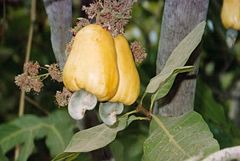 Cashews ready for harvest in Guinea-Bissau
| ||||||||||||||
| Scientific classification | ||||||||||||||
| ||||||||||||||
| Anacardium occidentale L. |
The Cashew (Anacardium occidentale; syn. Anacardium curatellifolium A.St.-Hil.) is a tree in the flowering plant family Anacardiaceae. The plant is native to northeastern Brazil, where it is called by its Portuguese name Caju (the fruit) or Cajueiro (the tree). It is now widely grown in tropical climates for its cashew "nuts" (see below) and cashew apples.
It is a small evergreen tree growing to 10-12 m tall, with a short, often irregularly-shaped trunk. The leaves are spirally arranged, leathery textured, elliptic to obovate, 4 to 22 cm long and 2 to 15 cm broad, with a smooth margin. The flowers are produced in a panicle or corymb up to 26 cm long, each flower small, pale green at first then turning reddish, with five slender, acute petals 7 to 15 mm long.
What appears to be the fruit of the cashew tree is an oval or pear-shaped accessory fruit or false fruit that develops from the receptacle of the cashew flower. Called the cashew apple, better known in Central America as "marañón", it ripens into a yellow and/or red structure about 5–11 cm long.
The true fruit of the cashew tree is a kidney or boxing-glove shaped drupe that grows at the end of the pseudofruit. Actually, the drupe develops first on the tree, and then the peduncle expands into the pseudofruit. Within the true fruit is a single seed, the cashew nut. Although a nut in the culinary sense, in the botanical sense the fruit of the cashew is a seed. However, the true fruit is classified as a nut by some botanists. The seed is surrounded by a double shell containing a caustic phenolic resin, urushiol, a potent skin irritant toxin also found in the related poison ivy. Some people are allergic to cashews, but cashews are a less frequent allergen than some other nuts.
Other vernacular names include cajueiro, cashu, casho, acajuiba, caju, acajou, acaju, acajaiba, alcayoiba, anacarde, anacardier, anacardo, cacajuil, cajou, gajus, jocote maranon, maranon, merey, noix d’acajou, pomme cajou, pomme, jambu, jambu golok, jambu mete, jambu monyet, jambu terong, kasoy. In the Antilles, specifically Puerto Rico, it is known as pajuil and the pseudofruit is the main used part as raw fruit.
Cashew Industry
Originally spread from Brazil by the Portuguese, the cashew tree is now cultivated in all regions with a sufficiently warm and humid climate.
Cashew is produced in around 32 countries of the world. The world production figures of cashew crop, published by FAO, was around 2.7 million tons per annum. The major raw cashew producing countries with their production figures in 2005 (as per the UN's Food and Agriculture Organization) are Vietnam (960,800 tons), Nigeria (594,000), India (460,000 tons), Brazil (147,629 tons) and Indonesia (122,000 tons).
World’s total area under the cultivation of cashew is around 35,100 km². India ranks first in area utilized for cashew production, though its yields are relatively low. The world’s average yield is 700 pounds per acre (780 kg/hectare) of land
Collectively, Vietnam, India and Brazil account for more than 90% of all cashew kernel exports. Some varieties of cashews come from Kollam or Quilon in Kerala, South India which alone produces 4,000 tons of cashews per annum. The major trading centers of cashew in India are Palasa, Kollam or Quilon Mangalore and Kochi.
Uses
The cashew apple is used for its juicy but acidic pulp, which can be eaten raw or used in the production of jam, chutney, or various beverages. Depending on local customs, its juice is also processed and distilled into liquor or consumed diluted and sugared as a refreshing drink, Cajuína. Ripe cashew apples also make good caipirinha. In Goa, India, the cashew apple is the source of juicy pulp used to prepare fenny, a locally popular distilled liquor. In Nicaragua the cashew apple has many uses, it is often eaten or made into juice and also processed to create sweets and jellies. Other uses in Nicaragua include fermentation to produce wine and home-vinegar.[1] The cashew apple contains much tannin and is very perishable. For this reason, in many parts of the world, the false fruit is simply discarded after removal of the cashew nut.
The urushiol must be removed from the dark green nut shells before the seed inside is processed for consumption; this is done by shelling the nuts, a somewhat hazardous process, and exceedingly painful skin rashes (similar to poison-ivy rashes) among processing workers are common. In India urushiol is traditionally used to control tamed elephants by its mahout (rider or keeper). The so-called "raw cashews" available in health food shops have been cooked but not roasted or browned.
Cashew nuts are a common ingredient in Asian cooking. They can also be ground into a spread called cashew butter similar to peanut butter. Cashews have a very high oil content, and they are used in some other nut butters to add extra oil. Cashews contain 180 calories per ounce (6 calories per gram), 70% of which are from fat.
The liquid contained within the shell casing of the cashew, known as Cashew Nut Shell Liquid (CNSL), has a variety of industrial uses which were first developed in the 1930s. CNSL is fractionated in a process similar to the distillation of petroleum, and has two primary end products: solids that are pulverized and used as friction particle for brake linings, and an amber-colored liquid that is aminated to create phenalkamine curing agents and resin modifiers. Phenalkamines are primarily used in epoxy coatings for the marine and flooring markets, as they have intense hydrophobic properties and are capable of remaining chemically active at low temperatures.
See also
- Wild Cashew - the species Anacardium excelsum
References and external links
- ↑ "Nicaraguan Fruits: Vashew", ViaNica. Retrieved 2007-07-13.
- Morton, J. F. Fruits of Warm Climates. ISBN
- Fruits of Warm Climates online
- Handbook of Energy Crops - Anacardium occidentale L.
- Cajueiro - Tropical plant database by Raintree Nutrition
- History of the industrial use of Cashew Nutshell Liquid
- King's American Dispensatory: Anacardium occidentale (Cashew-Nut)
- Research Paper on the Cashew Processing Industry in West Africa
- Anacardium.info is a cashew portal with more than 200 documents available. Presentation in French, most documents in English
- East Wind Community An intentional egalitarian community in Missouri that produces various natural and organic nut butters, including roasted and raw cashew butter.Its also known as "Godambi" in Kannada, a South Indian Language
- Cashew industry overview 2005
Picture Gallery
Cashew Fruit- Stages of Development
Credits
New World Encyclopedia writers and editors rewrote and completed the Wikipedia article in accordance with New World Encyclopedia standards. This article abides by terms of the Creative Commons CC-by-sa 3.0 License (CC-by-sa), which may be used and disseminated with proper attribution. Credit is due under the terms of this license that can reference both the New World Encyclopedia contributors and the selfless volunteer contributors of the Wikimedia Foundation. To cite this article click here for a list of acceptable citing formats.The history of earlier contributions by wikipedians is accessible to researchers here:
The history of this article since it was imported to New World Encyclopedia:
Note: Some restrictions may apply to use of individual images which are separately licensed.
